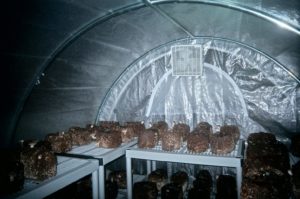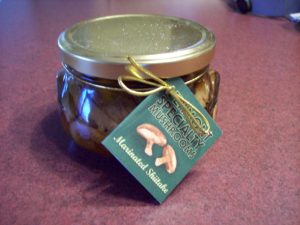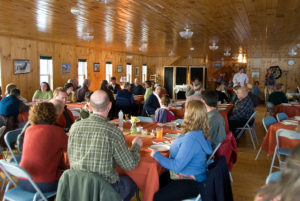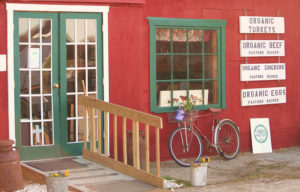New Uses for Old Barns: Reframing the Venerable Red Vermont Landmark
Vermont’s red barn, once the hallmark of the small family dairy farm, is now the centerpiece of a changing agricultural landscape. It is being reframed and reformed for new, often unusual enterprises. While dairy production still tops the agricultural economic scale in Vermont, the actual number of dairy farms is declining due to new technologies, improved genetics and larger dairies. But as new, young and older farmers move in or veteran dairy producers retool for new endeavors, the barn is taking on new life.
Tweed Valley Farm – Pittsfield, Vermont

Shitake mushrooms growing inside a greenhouse, which are set up inside Tweed Valley’s barn. Photo by Fred Simon
Tweed Valley Farm began its latest incarnation in 2002 when a newly married couple named Nancy Cooper Wisner and Fred Simon fled from their New Jersey home. They could “see the smoke from the fall of the Twin Towers” on that fateful day.
Not long after, Nancy and Fred found themselves signing a contract for a far-from-perfect property. The “big pink barn” had been the unlikely home of a successful furniture store. The house was “a nightmare”. But, Nancy says, “the farm had neighbors, a town, wood, and a river across the street for water” and they were motivated to become more self-reliant.
Prior to moving to Vermont Nancy had spent years in sales and marketing in the garden industry and she clearly has an entrepreneurial spirit. With time and research she began to get an image of what they would produce. She wanted to do something that was different and that could provide a consistent income. “Everyone was doing eggs, beef, milk and veggies.” She settled on mushrooms.

Marinated mushrooms are Tweed Valley’s newest product. Photo by Fred Simon
Today, 120 shiitake mushroom logs are thriving along with oyster bags in the 8×8 hoop-style greenhouses in the middle section of the 8,000 square foot barn that began life in the 1850s as a dairy farm on the Tweed River. Another section houses the quail hatching incubator, five brooder pens and 5 grow out pens for the hundreds of quail that are sold for meat and eggs. Still another section is the goat shelter for the Nigerian dwarfs that are raised for milk and breeding stock.
After several years of selling Vermont Specialty Mushrooms, and quail year-round at the Farmer’s Market in Rutland, Nancy has embarked on a new venture; marinated shiitake mushrooms. She has test-marketed them at the Farmer’s Market and other venues to great reviews.
Nancy has vivid, often humorous memories of their early years recalling two seniors renovating the barn, lowering the floor to pasture level, lugging an old chicken barn in pieces up the street and attaching it to the barn. She speaks of the barn that became the setting for a life where they “have learned so much” and it has erased Nancy’s fear of having nothing to do.
Applecheek Farm – Hyde Park Vermont
John and Judy Clark started their farm in 1965 with ten cows. Over the years, they grew the dairy herd to a peak of 120 holsteins, added pigs, emus, beef, poultry, geese and incorporated agritourism events. Education was a big part of their philosophy. Bringing families and school children to the farm, letting them see the operation and perhaps buy some beef, chicken, or eggs were important values.

Once a bunker silo, this space now hosts a monthly localvore dinner. Photo by Applecheek Farm
The Clarks had two sons who were invested in the farm but had their own ideas and interests. Oldest son, John converted the conventional stanchion barn to a streamlined parlor with a store so that visitors could see the entire milking, calving and processing operation and hopefully buy some of the end products.
Son Jason is a chef and his vision was to open a catering business on the farm. The Clarks had already built a bunker silo which had evolved over time into a ‘community hall’ for various meetings and local gatherings. As Jason’s reputation spread as a chef providing delicious local farm food (when it didn’t have the cache it does today) the Clarks added a kitchen with freezers downstairs from the main hall so that Jason could sell frozen meals to the growing number of visitors.
Jason now offers a monthly localvore dinner which has become very popular. Judy says, “We also rent the hall for retreats, workshops, family reunions and weddings”. But their interest in the educational aspect of the farm operation continues to grow and they are exploring a number of possibilities with other organizations as a means of sustaining the farm. “We want to renovate the bottom of the barn to include classrooms and rooms for overnight stays.
Judy says, “We have converted the end of the dairy barn, now called Applecheek Localvore Farm Market.” It is now the outlet for their extensive farm products from pork, poultry, beef and veal to vegetables, raw milk and products from other local farms.
The Clarks are currently milking about 40 cows as the industry continues to constrict and prices fluctuate radically. It is likely that the barns will be reinvented yet again as they grow the meat business, expand their CSA and continue to frame the educational programs. They are moving with the times, retrofitting the barns and looking to the future.
New Lives for Old Barns in the Morrisville region
George Cook, a veteran UVM Extension Farm Safety Specialist, has seen many old dairy barns morph into unimagined uses lately. “The [Lehouillier] family dairy barn became a farm stand with fruits and veggies when the father died. Later, the family changed it again and it’s now Johnson Hardware. That facility is making way more money than before and Mrs. Lehouillier is still behind the cash register.” George describes an old barn put to use as a seeding area for a nursery, and a couple others turned into apartment buildings. Others are being upgraded by the younger generation for a future in dairy farming. He describes the [name] family farm in [location]: “They have modern milking facilities, a totally new milking parlor and up to 200 cows”.
Vermont Division for Historic Preservation
After twenty years of providing grants to repair and retain historic barns, the Vermont Division awarded “nearly a quarter million dollars” to sixteen recipients this year according to its administrator, Judith Ehrlich. These grants must be matched and the barns must be at least 50 years old to qualify. The top dollar award is $15,000. The awards are not necessarily contingent on a continued agricultural use, “but most are” according to Ehrlich. The categories of requests usually fall into three areas: young couples coming to Vermont to farm, families inheriting the farm, and new buyers who are resurrecting abandoned barns. In one case, the new buyer bought a farm that was out of use for twenty years. It had belonged to one family for over a century. The new buyer wanted to restore the farm to its agricultural ‘roots.’
Despite the many times that we have heard over the years to expect an agricultural doomsday, the future looks reasonably healthy for Vermont farms, especially in light of the localvore movement, concerns over food security, food safety and most importantly the need to change our food habits for better health.



Hi
I have greenhouses. What do I need to change to grow mushrooms inside. Do I need extra equipment?